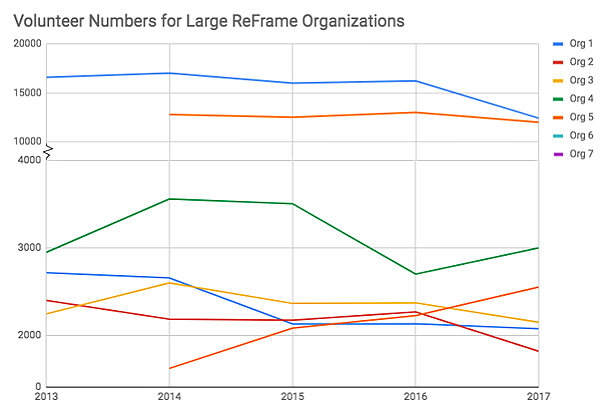Trends in Home Repair Volunteer Numbers & Recruitment Ideas
Earlier this year, we looked at how many volunteers it takes to repair a home. Now we are exploring trends in volunteer numbers for ReFrame Association members over the last 5 years. We currently have more than 50 organizational members of ReFrame Association, but we are only using data from the 20 organizations for which we have at least 4 years worth of information.
Volunteer recruitment is one of the biggest challenges for most home repair nonprofits. Some ReFrame Association members rely on staff and contractors to complete repairs for low-income families, but most facilitate volunteers who accomplish the bulk of the work. The more volunteers a nonprofit has, the more homes it can repair. And, of course, volunteers are not just a means to an end. Volunteers can have transformational experiences because of their home repair service and experience processing.

Large organizations (7 nonprofits with 2,000+ home repair volunteers annually):
- Four of these organizations had their highest volunteer numbers in 2013 or 2014, and have been experiencing a decline since. The decreases ranged from 17% to 27%; the average decline was 22%. These are all faith-based nonprofits that host mission trip groups.
- Two nonprofits (also mission-trip-focused) had more static volunteer numbers, having fluctuations of 7-15%. They had some increases and decreases but no obvious downward trend.
- One organization, however, increased their volunteers by 57% in 4 years. They are a secular organization that facilitates local volunteers.

Small and medium organizations (13 nonprofits with fewer than 2,000 volunteers annually):
- These nonprofits faired better overall. Seven of these organizations increased their number of volunteers. The increases ranged from 16% to 272%; the average increase was 72% and the mean increase was 50%. The program models of these organizations vary, but the two nonprofits with the most growth rely primarily on local volunteers.
- One nonprofit’s volunteer numbers were fairly static (except for a large increase one year due to a reason unknown to us).
- Five organizations’ volunteer numbers peaked in 2013-2015 and then declined. The decreases ranged from 15% to 64%; the average decline was 37%. The decreases were mostly caused by having fewer church mission trip volunteers.
Members cited these reasons for declining numbers of home repair volunteers:
- Decreases in the average size of church volunteer groups, especially among mainline denominations (this was the most frequently cited cause).
- Difficulties recruiting new church groups.
- Increased volunteer cancellations, possibly due to lower levels of commitment and shorter attention spans in this “smartphonified" world.
- Increased competition in the short-term missions sector.
- Increased expectations on young people's time from non-church activities.
- A lack of willingness of volunteers to meet program requirements such as giving up cell phones during the service experience or working on “risky” projects that require ladders and power tools.
- A changing view of the value of short-term missions.
- Disaster response trips divert some people away from volunteering in areas with persistent poverty.
- Substantial increases in transportation costs such as rental vans.
- Other factors cited include the changing view of poverty in Appalachia (and probably elsewhere), turmoil within the Methodist church (and most likely other denominations too), and difficulties finding temporary facilities that can host large volunteer groups.
- Some organizations experienced unique challenges; one nonprofit changed their name, which hurt their search engine optimization.
So what can we do?
Recruit groups other than churches. Joseph Baker, a sociologist of religion at East Tennessee State University, offered this insight and during his presentation at ReFrame Conference 2017, in light of declining church attendance in the United States: “Secular people care about the poor at the same rates as religious people. The key is finding a way to connect with and integrate people into volunteering opportunities other than organized religion.” He suggested the Secular Student Alliance as a potentially useful partner for home repair nonprofits. Appalachia Service Project is forming partnerships with other volunteer organizations and trying to diversify their volunteer base.
Consider new program models. Raise the Roof Project is supplementing their mission trip volunteer program with local adults who serve one or more days. They also facilitate local churches who serve for a week but don’t want evening programming. A unique model and technological resource for connecting local volunteers with local people in need of home repairs is NeighborLink.
Make it easier to volunteer. Verified Volunteers, a partner of ReFrame Association, says that financial stress is a factor contributing to the loss of volunteer hours. Families struggling to earn money don’t have time to volunteer. They say, “Streamlining the recruiting and on-boarding process for volunteers is one way to tackle this time and cost issue.” Learn more. For volunteer programs that charge fees, consider starting a scholarship fund to reduce the cost for those who want to participate but cannot afford to do so.
Focus on retaining volunteers. It costs less to retain volunteers than to recruit new ones. Having a high retention rate (95%) is one of the reasons Chesapeake Housing Mission believes they’ve been able to double their number of volunteers over the last 5 years. Recognizing volunteers is an important key to retention; here is a related thought-leadership piece from Verified Volunteers: “Volunteer Recognition eToolkit: Beyond Pins, Plaques, and Parties."
Improve the volunteer experience. This is one of the best ways to get more Americans to volunteer, according to an article in The Conversation, an independent source of news from the academic and research community. They emphasize the importance of actively managing, supporting, and funding volunteer programs. The authors wrote another article that provides a framework for helping nonprofit leaders to understand where to focus their efforts and resources to have the greatest impact.
Form partnerships. Rebuild Upstate cites community partnerships as one of the key factors in their growth (they had 272% more volunteers in 2017 than in 2013). The City of Greenville, South Carolina contracted with them to manage its home repair/home rehab program and they also partner with three area agencies on aging, the state housing trust fund, and the Greenville County Redevelopment Authority. ReFrame members can access a presentation from ReFrame Conference 2017 that explores other factors of Rebuild Upstate’s impressive growth.
Register for “Great Marketing + Great Selling = More Volunteers!” This pre-conference workshop led by the marketing firm Engenius will be held before ReFrame Conference on November 7. This class will review the best marketing practices from home repair nonprofits, give tactical next steps for implementing marketing techniques that have proven beneficial for others, and help home repair nonprofits think about their sales process more strategically. Learn more and register.

